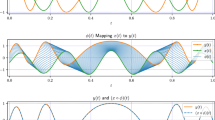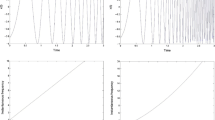Abstract
In this paper, we propose a new warping function to create a new class of warped time-frequency representations (TFRs). We provide the formula for the derivative warping function and its inverse which is defined using the Lambert-W function. Examples are provided demonstrating how the new warping function can be successfully used on wide variety of nonlinear FM chirp signals to linearize their support in the warped time-frequency plane. An algorithm is proposed to optimize the parameter of the new warping function. We also formulate nonlinear FM chirp signals that are ideally matched to this new class of TFRs. These matched FM chirp signals have highly concentrated warped TFRs and no inner-interference terms.







Similar content being viewed by others
References
R.G. Baraniuk, Warped perspectives in time-frequency analysis, in Proceedings of the IEEE-SP International Symposium on Time-Frequency and Time-Scale Analysis (1994), pp. 528–531
R.G. Baraniuk, Unitary equivalence: a new twist on signal processing. IEEE Trans. Signal Process. 43, 2269–2282 (1995)
R.G. Baraniuk, P. Flandrin, A.J. Janssen, O.J. Michel, Measuring time-frequency information content using the Rényi entropies. IEEE Trans. Inf. Theory 47, 1391–1409 (2001)
J. Bertrand, P. Bertrand, A class of affine wigner functions with extended covariance properties. J. Math. Phys. 33, 2515–2527 (1992)
J. Bertrand, P. Bertrand, Affine time-frequency distributions, in Time-Frequency Signal Analysis—Methods and Applications, ed. by B. Boashash (Longman-Cheshire, Melbourne, 1992), pp. 118–140
B. Boashash, P. O’Shea, Polynomial Wigner-Ville distributions and their relationship to time-varying higher order spectra. IEEE Trans. Signal Process. 42, 216–220 (1994)
B. Boashash, Time-Frequency Signal Analysis and Processing: A Comprehensive Reference (Academic Press, Cambridge, 2015)
L. Cohen, Time-frequency distributions: a review. Proc. IEEE 77, 941–981 (1989)
L. Cohen, Time-Frequency Analysis (Prentice-Hall, Englewood Cliffs, 1995)
R.M. Corless, G.H. Gonnet, D.E. Hare, D.J. Jeffrey, D.E. Knuth, On the Lambert W function. Adv. Comput. Math. 5, 329–359 (1996)
A. Feltane, Time-frequency based methods for non-stationary signal analysis with application to EEG signals. Ph.D Dissertation, Electrical Engineering Department, University of Rhode Island, Kingston, RI (2016)
P. Flandrin, R. G. Baraniuk, O. Michel, Time-frequency complexity and information, in Proceeding of IEEE International Conference on Acoustics and Speech Signal Processing, (ICASSP), Adelaide, Australia, vol. 3 (1994), pp. 329–332
P. Flandrin, Time-Frequency/Time-Scale Analysis (Academic, New York, 1999)
F. Hlawatsch, G.F. Boudreaux-Bartels, Linear and quadratic time-frequency signal representations. IEEE Signal Process. Mag. 9, 21–67 (1992)
F. Hlawatsch, A. Papandreou-Suppappola, G.F. Boudreaux-Bartels, The hyperbolic class of quadratic time-frequency representations-part II: subclasses, intersection with the affine and power classes, regularity and unitarity. IEEE Trans. Signal Process. 45, 303–315 (1997)
F. Hlawatsch, A. Papandreou-Suppappola, G.F. Boudreaux-Bartels, The power classes—quadratic time-frequency representations with scale covariance and dispersive time-shift covariance. IEEE Trans. Signal Process. 47, 3067–3083 (1999)
N. Holighaus, C. Wiesmeyr, P. Balazs, Construction of warped time-frequency representations on nonuniform frequency scales, Part II: integral transforms, function spaces, atomic decompositions and Banach frames (2015), Preprint available on arXiv:1503.05439
M.Z. Ikram, G.T. Zhou, Order determination and parameter estimation of multicomponent polynomial phase signals, in Ninth IEEE Workshop in Statistical Signal and Array Processing (1998), pp. 352–355
A. Jarrot, C. Ioana, A. Quinquis, Toward the use of the time warping principle with discrete time sequences. J. Comput. 2, 49–55 (2007)
D. Jones, T. Parks, A high resolution data-adaptive time frequency representation. IEEE Trans. Acoust. Speech Signal Process. 38, 2127–2135 (1990)
A.X. Lee, H. Lu, A. Gupta, S. Levine, P. Abbeel, Learning force-based manipulation of deformable objects from multiple demonstrations, in IEEE International Conference on Robotics and Automation (ICRA), Seattle, WA, USA (2015), pp. 177–184
N. Martinel, A. Das, C. Micheloni, A.K. Roy-Chowdhury, Re-identification in the function space of feature warps. IEEE Trans. Pattern Anal. Mach. Intell. 37, 1656–1669 (2015)
A. Papandreou, F. Hlawatsch, G.F. Boudreaux-Bartels, The hyperbolic class of quadratic time frequency representations, part I: constant-Q warping, the hyperbolic paradigm, properties, and members. IEEE Trans. Signal Process. 41, 3425–3444 (1993)
A. Papandreou-Suppappola, G.F. Boudreaux-Bartels, The exponential class and generalized time-shift covariant quadratic time-frequency representations, in Proceeding of the IEEE-SP International Symposium on Time-Frequency and Time-Scale Analysis, Paris, France (1996), pp. 429–432
A. Papandreou-Suppappola, L.T. Antonelli, Use of quadratic time-frequency representations to analyze cetacean mammal sounds. (No. NUWC-NPT-TR-11-284), Naval Undersea Warfare Center NEWPORT DIV RI (2001)
A. Papandreou-Suppappola, S.B. Suppappola, Analysis and classification of time-varying signals with multiple time-frequency structures. IEEE Signal Process. Lett. 9, 92–95 (2002)
A. Rényi, On measure of entropy and information, in 4th Berkeley Symposium on Mathematical Statistics and Probability, vol. 1 (1961), pp. 547–561
T. Twaroch, F. Hlawatsch, Modulation and warping operators in joint signal analysis, in Proceedings IEEE-SP International Symposium on Time-Frequency and Time-Scale Analysis (TFTS), Pittsburgh, PA, USA (1998), pp. 9–12
Z. Wang, A.C. Bovik, Mean squared error: love it or leave it? A new look at signal fidelity measures. IEEE Signal Process. Mag. 26, 98–117 (2009)
Author information
Authors and Affiliations
Corresponding author
Rights and permissions
About this article
Cite this article
Feltane, A., Boudreaux-Bartels, G.F. & Boudria, Y. Using the Lambert-W Function to Create a New Class of Warped Time-Frequency Representations. Circuits Syst Signal Process 37, 3191–3205 (2018). https://doi.org/10.1007/s00034-017-0733-0
Received:
Revised:
Accepted:
Published:
Issue Date:
DOI: https://doi.org/10.1007/s00034-017-0733-0




